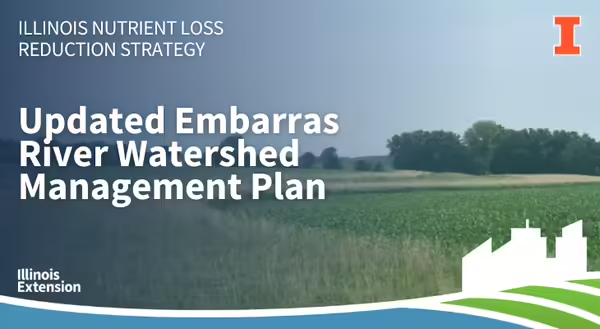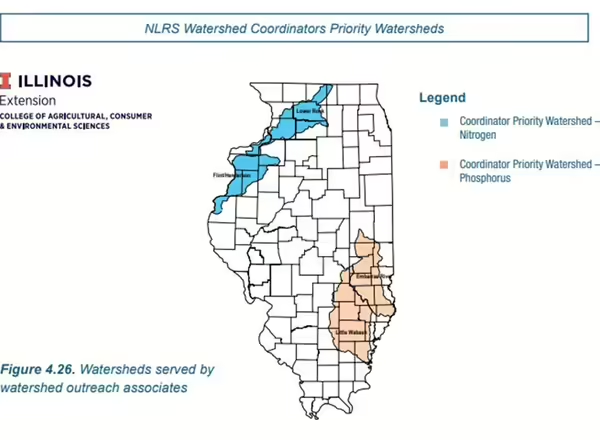
A watershed plan is a stakeholder-supported tool used to protect water resources and improve water quality. A watershed plan can also be used to leverage state and federal dollars for conservation practice adoption. The updated Embarras River Watershed (ERW) Management Plan, approved by the Illinois Environmental Protection Agency (IEPA) in December 2022, was years in the making and covers large parts of east-central Illinois. Nicole Haverback, University of Illinois Extension, and Lauren Spaniol, Coles County Soil and Water Conservation District (SWCD), were featured on the June 28 episode of the Illinois Farm Bureau’s (IFB) RFD radio to discuss watershed plans and specifically the approval of the ERW Management Plan.
What is a watershed plan?
In simple terms, a watershed is an area of land that directs all water to a common point. A watershed plan is a collaborative, stakeholder-supported tool to protect water within a watershed and downstream. In Haverback’s words, a watershed plan looks at the overall watershed to determine what pollutants are impairing water bodies, from urban stormwater and agricultural non-point sources. It addresses these water quality issues by supplying targeted recommendations of Best Management Practices (BMPs), or conservation practices, that aim to reduce pollutants over time. The plan is very specific to the watershed, its land use, and what local stakeholders are capable of and willing to do.
Developing a watershed plan is expensive, takes a lot of time, and requires engagement from stakeholders. The overall cost of creating a watershed plan is often offset by grant funding, like the 319 grant used in the ERW Management Plan. Once approved by the IEPA, the watershed plan can be used to secure grant funds for cost-share opportunities that support BMP adoption.
Priority watersheds
In the Illinois Nutrient Loss Reduction Strategy (NLRS), priority watersheds were designated in Illinois as a part of the strategy and identified using total phosphorus and nitrate-nitrogen loading data from the science assessment in the original report, information on local water quality conditions, and knowledge of watershed-based planning infrastructure. This enables people to concentrate their efforts on those watersheds specifically by addressing the issues more efficiently. Priority watersheds are those expected to have the greatest capacity to reduce high volumes of nutrient losses annually.
There are Watershed Outreach Associates with Illinois Extension that work in both priority areas (see map below from 2021 NLRS Biennial Report) to provide additional support. Haverback covers the two phosphorus-priority watersheds, which are the Embarras River Watershed and the Little Wabash River Watershed.

Embarras River Watershed Management Plan
Spaniol explains the progression of the ERW Management Plan, beginning in 2019. The Coles County SWCD applied for a 319 grant through IEPA with the IFB, Northwater Consulting, and Illinois Extension as partners, along with support from private groups, county Farm Bureaus, and SWCD boards throughout the watershed.
The initial goals were not only to update the 2011 iteration of the ERW Management Plan but also to prioritize subwatersheds and identify one or two subwatersheds for watershed planning. A series of partner meetings took place in 2019 to identify goals for the watershed plan update. The 319 grant was awarded in 2020. In January 2020, watershed planning meetings occurred throughout the region through a Nutrient Stewardship Grant, with support from county farm bureaus and SWCD, along with Illinois Extension. Over the next two years, additional meetings were focused on data collection and analysis, and culminated in the final ERW Management Plan update in 2022. The updated plans can be found on the Coles County SWCD website and will be coming to the IEPA website.
ABOUT THE AUTHORS
Rachel Curry is an Agriculture and Agribusiness Educator for two Nitrogen Priority Watersheds (Flint-Henderson and Lower Rock River Watersheds) and is housed in the Galva office of the Henry, Mercer, Rock Island, and Stark Counties Extension Unit. Rachel earned a B.S. in Environmental Studies from Knox College and an M.S. in Environmental Science and Soil Science from Iowa State University with an emphasis on soil fertility. She is interested in sharing information on the Illinois Nutrient Loss Reduction Strategy and agricultural conservation practices through discussion and outreach.
Nicole Haverback is a Watershed Outreach Associate for two Phosphorus Priority Watersheds (Embarras and Little Wabash River Watersheds) and is housed in the Effingham office of the Clay, Effingham, Fayette, and Jasper Counties Extension Unit. Nicole earned a BS in Agriculture and Rural Policy Studies from Iowa State University in May of 2022. She is interested in sharing information on the Illinois Nutrient Loss Reduction Strategy and agriculture conservation practices through discussion and outreach.
Sam Henry is an Agricultural Engineering student at the University of Illinois. Outside of classes, she works with Dr. Rodriguez in his BioMASS Lab, and learns about alternative agricultural methods in Illini Urban Farmers. She is in her third year, and is passionate about the nexus of clean water, sustainable agriculture, natural resources, and sustainability.
ABOUT THE BLOG
At Illinois Extension, we’re working to improve water quality at home and downstream. Every month, our watershed outreach associates will bring you stories highlighting agricultural conservation practices, current research projects and results, and from the field farmer interviews. The Nutrient Loss Reduction blog covers conservation practices recommended by the Illinois Nutrient Loss Reduction Strategy, timely updates, farm safety, and new decision tools to help farmers and producers reduce the nutrients leaving their field. Want to get notified when new blog posts are available? Subscribe at go.illinois.edu/SubscribeINLRS.